| Richard Barone: "Between Heaven And Cello" (Line, März 1994 |


 Mehr ...
Mehr ...
|
"Aus der Künstler-Keimzelle Hoboken in New Jersey kamen Anfang
der 80er The Bongos. Schon als deren Kopf fiel Songwriter Richard Barone
auf. Solo-Alben wie Cool
Blue Hello (1987) oder Clouds Over Eden (1992) beeindruckten mit ihrer
filigranen Delikatesse. Between Heaven And Cello knüpft da nahtlos
an. Im New Yorker Club Fez schwebt die meist träumerische Stimme
des Amerikaners in unaufdringlicher Live-Atmosphäre über sachten
Gitarren, umgarnt von einem melancholischen Cello, auch mal durch elektrische
Riffs getrieben. Echt und grandios." (Audio)
"Bei dieser Platte handelt es sich um Mitschnitte,
die 1993 im Rahmen mehrerer "Guitar And Cello"-Konzerte auf
einer Zweispur-DAT-Maschine live aufgezeichnet wurden. Mit Ausnahme von
drei Titeln, bei denen der Künstler eine Perkussionsbegleitung zuließ,
beschränkte sich Richard Barone in der Instrumentierung auf seine
Gitarre (mal elektrisch, mal akustisch) und ein Cello. Dennoch überrascht
das Album mit einer faszinierenden rhythmischen und atmosphärischen
Vielfalt. Hinzu kommen exzellente Songs, die Barone mit ebenso großer
Intensität wie Initmität vorträgt." (Stereoplay)
|
|
| Chris Cacavas & Junkyard Love: "Pale Blond Hell" (Normal, März 1994) |
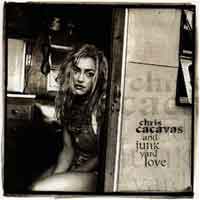 Für Eingeweihte der Killer im Cacavas-Programm. In definitiver Neil &
Crazy Horse Nähe ... Und ein tolles Cover! In diese blassblonde
Hölle würde sich sicherlich mancher von uns gerne begeben!
Für Eingeweihte der Killer im Cacavas-Programm. In definitiver Neil &
Crazy Horse Nähe ... Und ein tolles Cover! In diese blassblonde
Hölle würde sich sicherlich mancher von uns gerne begeben!

 Mehr ...
Mehr ...
... künstlerisch ist Chris Cacavas der härteste Rivale von Neil Young. Sein drittes Studioalbum ist sein Meisterwerk und sollte endlich den Durchbruch bringen. Für mich steht fest: eine der Platten des Jahres.
(HiFi Vision)
On his previous two releases, Chris Cacavas showed that he could create marvelous folk-inflected ballads and characterful soft rock songs. He also proved that no matter how good this material was, nobody paid attention but a small cult of fans, most of whom were in Europe. On Pale Blond Hell, Cacavas decided to try something different, turning out a gloriously raucous album of amplified rock in the tradition of Crazy Horse. The elements of twang and Western Americana that lifted his work above the usual were still there, but set to John Thoman's roaring guitar and Billy Price's pounding drums. This is not to say that there's no subtlety here, far from it in fact. The dynamics on this album are astonishingly complex. Listen to "Let You Down," in which Cacavas' soulful vocals and strummed acoustic guitar plays counterpoint to Thoman's distorted six-string howl, a carnival-like organ riff, and guest Joey Burns' cello. Cacavas sings with soul and intensity throughout this album, and though comparisons to Neil Young are inevitable, well, there are worse people to be compared to. Young himself would probably have been proud of tunes like "Smolder" and "Song for the Fan." The reception of Pale Blond Hell in Europe was ecstatic, and Cacavas became a festival headliner on the strength of this album. Alas, it was never released in the United States and the band toured the U.S. only fitfully, so Chris Cacavas & Junkyard Love were stars in Europe and unknowns in their own home towns.
(by Richard Foss, allmusic.com)
|
| Elvis Costello: "Brutal Youth" (März 1994) |
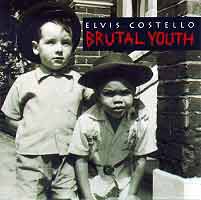

 Mehr ...
Mehr ...
The whole thing has an air of mad humour, being together again...It doesn't sound like an oldies band. I couldn't believe it when they cranked up behind me. It was the most ungodly thing...very exciting. It was like being strapped on the front of a runaway train...People are going to be very surprised. (EC)
|
| Nick Cave & The Bad Seeds: "Let Love In" (Mute, April 1994) |
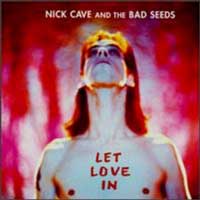 [Kicking Against The Pricks ]
[Kicking Against The Pricks ]

 Mehr ...
Mehr ...
»Let Love In« gilt für viele Kritiker als die Quintessenz des Werkes von Nick Cave & The Bad Seeds.
Keeping the same line-up from Henry's Dream, Nick Cave and company turn in yet another winner with Let Love In. Compared to Henry's Dream, Let Love In is something of a more produced effort -- longtime Cave boardsman Tony Cohen oversees things, and from the first track, one can hear the subtle arrangements and carefully constructed performances. Love, unsurprisingly, takes center stage of the album. Besides concluding with a second part to "Do You Love Me?," two of its stronger cuts are the (almost) title track "I Let Love In," and "Loverman," an even creepier depiction of lust's throttling power so gripping that Metallica ended up covering it. On the full-on explosive front, "Jangling Jack" sounds like it wants to do nothing but destroy sound systems, strange noises and overmodulations ripping throughout the song. The Seeds can always turn in almost deceptively peaceful performances as well, of course -- standouts here are "Nobody's Baby Now," with a particularly lovely guitar/piano line, and the brooding drama of "Ain't Gonna Rain Anymore." The highlight of the album, though, has little to do with love and everything to do with the group's abilities at music noir. "Red Right Hand" depicts a nightmarish figure emerging on "the edge of town," maybe a criminal and maybe something more demonic. Cave's vicious lyric combines fear and black humor perfectly, while the Seeds' performance redefines "cinematic," a disturbing organ figure leading the subtle but crisp arrangement and Harvey's addition of a sharp bell ratcheting up the feeling of doom and judgment.
(by Ned Raggett, All Music Guide)
|
| Bruce Cockburn: "Dart To The Heart" (Columbia, April 1994) |
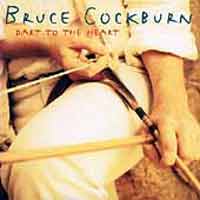 Ich bin eigentlich kein sonderlich großer Cockburn-Fan - aber etwas
kurioserweise sind gerade seine beiden 90er-Alben beim Majorlabel
Sony/Columbia für mich deutlich seine besten. Das liegt vielleicht
an den guten Produktionsbedingungen (beide sind von T-Bone Burnett
betreut und klingen phantastisch!), den erstklassigen Musikern (u.
a. Elvis-Bassist Jerry Scheff, Drummer Mickey Curry,
Landsmann Richard Bell von The Band am Piano und den Slidegitarrenmeistern
Greg Leisz und Colin Linden) und natürlich den
guten Songs des Kanadiers Cockburn.
Ich bin eigentlich kein sonderlich großer Cockburn-Fan - aber etwas
kurioserweise sind gerade seine beiden 90er-Alben beim Majorlabel
Sony/Columbia für mich deutlich seine besten. Das liegt vielleicht
an den guten Produktionsbedingungen (beide sind von T-Bone Burnett
betreut und klingen phantastisch!), den erstklassigen Musikern (u.
a. Elvis-Bassist Jerry Scheff, Drummer Mickey Curry,
Landsmann Richard Bell von The Band am Piano und den Slidegitarrenmeistern
Greg Leisz und Colin Linden) und natürlich den
guten Songs des Kanadiers Cockburn.

 Mehr ...
Mehr ...
"On his 22nd release, Bruce Cockburn shows why he has
been a mainstay on the folk/rock scene for the last quarter-century. Featuring
a variety of musical influences, coupled with intelligent lyrics and catchy
melodies, Dart to the Heart is an accessible and likeable album.
Dart to the Heart boasts a strong cast that brings out the best in Cockburn.
Produced by T-Bone Burnett and featuring Greg Leisz (from k.d. lang's band)
on pedal steel guitar, Richard Bell on keyboards, and the legendary Jerry
Scheff (who has worked with a huge number of musicians, ranging from Elvis
Presley to The Doors to Elvis Costello) on bass, Dart to the Heart is ultimately
built around Cockburn's strong guitar work and gentle songwriting.
Cockburn admits that he was looking for more melodic hooks on this album.
Says Cockburn, "A lot of the songs on [the album] were written in hotel
rooms and dressing rooms on the last tour, so they are written on acoustic
guitar because that's what I had at the time. When I'm at home and I have
my stuff all set up and plugged in, I might break more on the electric .
. . It struck me at one point that I had almost no songs a non-musician
could just sit around and sing. I'd rather be remembered for having written
songs that people could sing at a party or whatever. It seemed like there
was a bit of a gap there, and I was trying to address it and still am on
the current album."
While the opening cut, "Listen for the Laugh" (which is now receiving
local airplay) has a Lou Reed feel in its spare, driving guitar lead, the
next cut ("All the Ways I Want You") slips into a folksier groove
that is reminiscent of Gordon Lightfoot (as is appropriate, considering
that Cockburn is also from Canada).
Yet in the end, Cockburn is his own man, heading down the solitary path
followed by other guitar-oriented roots rockers such as Graham Parker and
Richard Thompson. With the dripping steel guitar of Greg Leisz featured
on the slower "Bone in My Ear," and Cockburn's own fingerwork
spotlighted on the lovely acoustic number, "Closer to the Light,"
Cockburn shows that his real forte is as a singer/songwriter in the folk/roots
vein.
Cockburn has been around long enough to have truly pondered the big questions
of life. In discussing mortality, he says "Death is an inescapable
part of life. It is as much a part of life as birth. The things that scare
us about death are fear of the unknown or the loss of a loved one, or the
fear that our lives will have no meaning. But life and death can't be opposites.
If we believe there's any value to life at all, then death in some way must
be welcomed. If life has meaning, then death does to."
Which is not to say that Cockburn is on a downer -- he's just intent on
exploring the mysteries of life. Dart to the Heart is a terrific album,
balancing strong guitar parts and smart songs against a quarter-century
of experience in the industry. Find this album." (Randy
Krbechek) |
|
| Emmylou Harris: "Cowgirl's Prayer" (Grapevine, April 1994) |
 Mal wieder ein schönes Studioalbum von Frau Harris, eingespielt z.T. mit den Nash Ramblers (Sam Bush,
Jon Randall, Al Perkins, Roy Huskey, Larry Atamanuik), aber nicht mehr so
bluegrassmäßig wie der Vorgänger Live At The Ryman.
Mal wieder ein schönes Studioalbum von Frau Harris, eingespielt z.T. mit den Nash Ramblers (Sam Bush,
Jon Randall, Al Perkins, Roy Huskey, Larry Atamanuik), aber nicht mehr so
bluegrassmäßig wie der Vorgänger Live At The Ryman.

 Mehr ...
Mehr ...
In den USA ist dieses Album schon 1994 erschienen, bei uns erst mit zweijähriger Verspätung. Schade, daß erst so spät, zum Glück, daß überhaupt noch. Denn "Cowgirl's prayer" ist eine Sammlung unter die Haut gehender, kitschfreier Country-Balladen. Selbst Songs von Tony Joe White ("High powered tove") und Leonard Cohen ("Ballad of a runaway horse" ) ringt das Cowgirl neue Töne ab. Hut ab!
|
| The Schramms: "Little Apocalypse" (Normal, April 1994) |
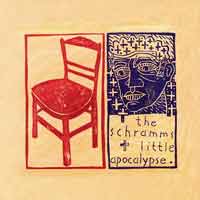 Zweites Album der Band um den ehemaligen Yo La Tengo-Gitarristen David Schramm.
Der einzigen Coverversion auf der Platte gebührt die Ehre, auch für Waiting For Louise einen Konzertklassiker gefunden zu haben:
"Side Of The Road" von Lucinda Williams!
Zweites Album der Band um den ehemaligen Yo La Tengo-Gitarristen David Schramm.
Der einzigen Coverversion auf der Platte gebührt die Ehre, auch für Waiting For Louise einen Konzertklassiker gefunden zu haben:
"Side Of The Road" von Lucinda Williams!

 Mehr ...
Mehr ...
The Schramms already had intelligence and maturity to spare when they cut their second album, Rock, Paper, Scissors, Dynamite, but the two years of seasoning that preceded the recording of 1994's Little Apocalypse is audible from the first play. While the Schramms already sounded tight on their earlier recordings, they sound positively intuitive on these sessions (especially Ron Metz, whose drumming offers lots of subtle color without calling attention to itself), and Dave Schramm's guitar playing has, if anything, grown even more striking and inventive, confirming his status as one of America's greatest unsung guitarists. And while Rock, Paper, Scissors, Dynamite sounded like a set of great songs, Little Apocalypse is a great album, displaying a greater thematic unity and enough tonal variety to keep it compelling from start to finish. And Little Apocalypse is dark enough to live up to its title, full of casual murders, angry apparitions, songs of the sirens, and vengeful final words alongside Schramm's usual tales of romantic distress and emotional discombobulation, painting a vivid picture of a world where things aren't quite right made all the more familiar by Schramm's warm, well-worn voice. (For good measure, the band also offers up another of its stellar covers: in this case, an inspired reading of Lucinda Williams' "Side of the Road.") A striking mix of the comfortable and the troubling, Little Apocalypse is a superb album from a band just hitting the top of its form.
(by Mark Deming, All Music Guide)
|
| David McComb: "Love Of Will" (Mushroom, Mai 1994) |
 Das
wunderschöne und - leider - einzige Soloalbum des ehemaligen Sängers
und Songschreibers der Triffids,
nach den Go-Betweens und noch vor
The Church und Crowded
House meine liebste Band aus Australien. Das
wunderschöne und - leider - einzige Soloalbum des ehemaligen Sängers
und Songschreibers der Triffids,
nach den Go-Betweens und noch vor
The Church und Crowded
House meine liebste Band aus Australien.
(12.01.2009) |
| Sonic Youth: "Experimental Jet Set Trash & No Star " (Geffen, Mai 1994) |
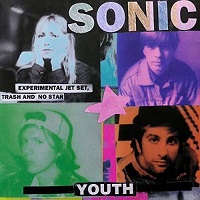
(21.04.2019)

 Mehr ...
Mehr ...
Whereas Dirty and its predecessors were loud, distorted, and bordering on the fine line between pop and noise, Experimental Jet Set, Trash & No Star did away with the ear-bleeding guitar feedback so often attributed to the group. The group retained its quirky twist on pop/rock song structures, moving even closer to a consistent use of the verse-chorus-verse template. Of course, the disregard for mosh-friendly guitar riffs, lack of crowd-surfing intensity, and increasing traces of normalcy killed a large part of the group's momentous surge in popular acceptance, damning them once again to the status of often misunderstood artists. Popular opinion may have wanted more rock than what Sonic Youth wanted to deliver on this album, yet upon careful inspection, Experimental Jet Set, Trash & No Star still out-noises the majority of its peers. Butch Vig's clean production makes the album seem clean, when in actuality it is nearly as dirty as the group's preceding effort. Songs such as "Starfield Road" and the acoustic song "Winner's Blues" emanate plenty of raw spontaneity, even with Vig's crystal clear production. Relative to Sonic Youth's greater body of work, the album does seem rather sedate, though. The noises resonate subtly rather than mangle one's eardrum. In sum, this record must be considered the closest the group has ever gone to straight-ahead pop/rock. With all of the feedback, murky production, incoherent song structuring, and rambunctious charisma stripped away, what remains are odd lyrics and unique guitar nuance. In other words, Experimental Jet Set, Trash & No Star features the underlying foundation of the group's music standing naked, without any of their traditionally excessive static to heighten it.
(by Jason Birchmeier, All Music Guide)
|
| Walkabouts: "Setting The Woods On Fire" (Glitterhouse/Sub Pop, Mai 1994) |
 Ihr
letztes reguläres Studio-Werk auf Glitterhouse, vor dem Wechsel
zu Virgin. Vom Gefühl her liegt es mittig zwischen der rockigeren
"New West Motel" und
der folkigen "Satisfied Mind".
12 Songs, von denen vor allem "Bordertown", "Sand &
Gravel", "Graveyard" und "Promised" (welches
direkt von "Satisfied Mind" stammen könnte) auf eine
"Best Of" gehören (gäbe es eine). Ihr
letztes reguläres Studio-Werk auf Glitterhouse, vor dem Wechsel
zu Virgin. Vom Gefühl her liegt es mittig zwischen der rockigeren
"New West Motel" und
der folkigen "Satisfied Mind".
12 Songs, von denen vor allem "Bordertown", "Sand &
Gravel", "Graveyard" und "Promised" (welches
direkt von "Satisfied Mind" stammen könnte) auf eine
"Best Of" gehören (gäbe es eine).
"Unwiderstehlich gut." (Fachblatt)
"Ein Album mit zwölf taufrischen Songs -
elektrisch und elektrisierend zugleich. Beinahe so, als würde
sich Neil Young an `Exile On Main Street´ von den Stones probieren." (ME/Sounds)
|
| Everything But The Girl: "Amplified Heart" (WEA/Blanco Y Negro, Juni 1994) |
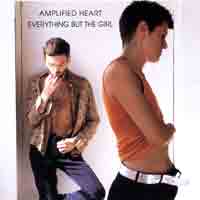 10
Jahre nach dem Debüt "Eden"
mal wieder ein Album von Tracy Thorn und Ben Watt, das
mir rundherum gefällt, was vor allem an der Rückkehr zum alten
folkig-jazzigen Sound, diesmal von England Folk-Kontrabass-Legende Danny
Thompson und Ex-Fairport Convention-Trommler Dave Mattacks
mit Perkussiont Martin Ditcham (den man vor allem von Talk
Talk-Platten kennt) erzeugt. Aber natürlich sind wie immer
die Stimme von Tracy und die Songs das Wichtigste. Herausragend für
mich die Eröffnungsnummer "Rollercoaster" mit einer hübschen
Minimoog-Melodie. Im Oktober 1995 wurde kurioserweise der Titel "Missing
You" in einer Disco-Remix-version mit einem kräftigen Computerbeat
zu einem der größten Hits der Band. Ich mag natürlich
das spartanische Original viel lieber, gönne den beiden aber natürlich
den späten & unverhofften Riesenerfolg. 10
Jahre nach dem Debüt "Eden"
mal wieder ein Album von Tracy Thorn und Ben Watt, das
mir rundherum gefällt, was vor allem an der Rückkehr zum alten
folkig-jazzigen Sound, diesmal von England Folk-Kontrabass-Legende Danny
Thompson und Ex-Fairport Convention-Trommler Dave Mattacks
mit Perkussiont Martin Ditcham (den man vor allem von Talk
Talk-Platten kennt) erzeugt. Aber natürlich sind wie immer
die Stimme von Tracy und die Songs das Wichtigste. Herausragend für
mich die Eröffnungsnummer "Rollercoaster" mit einer hübschen
Minimoog-Melodie. Im Oktober 1995 wurde kurioserweise der Titel "Missing
You" in einer Disco-Remix-version mit einem kräftigen Computerbeat
zu einem der größten Hits der Band. Ich mag natürlich
das spartanische Original viel lieber, gönne den beiden aber natürlich
den späten & unverhofften Riesenerfolg. |
| Robert Forster: "I Had A New York Girlfriend" (Beggars Banquet, Aug. 1994) |
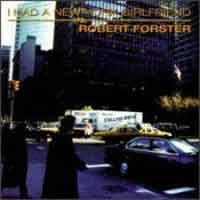 Der Ex-Go-Betweens-Sänger mit
seiner Sammlung von Lieblingsliedern anderer Autoren. Wird von vielen
Spezis nicht als seine Glanztat eingeschätzt. Ich als alter Fan
schöner Coverversionen find es aber toll!
Der Ex-Go-Betweens-Sänger mit
seiner Sammlung von Lieblingsliedern anderer Autoren. Wird von vielen
Spezis nicht als seine Glanztat eingeschätzt. Ich als alter Fan
schöner Coverversionen find es aber toll!
- Nature's Way - Randy California (Spirit)
- Broken Hearted People - Guy Clark
- Echo Beach - Martha & The Muffins
- Tell Me That It Isn't True - Bob Dylan
- 2541 - Grant Hart (Ex-Hüsker Dü)
- Anytime - Ricky Nelson
- Locked Away - Keith Richards
- Look Out Here Comes Tomorrow - Neil Diamond (Hit für Monkees)
- Alone - Kelly/Steinberg (Hit für Heart)
- Bird - Mick Hansonis (King Candy, Köln)
- Frisco Depot - Mickey Newbury
- 3 A.M. - Bill Anderson
|

 Mehr ...
Mehr ...
Robert Forster, erstwhile co-writer of The Go-Betweens, is a lanky, committed individual of Australian extraction with an occasional fondness for stage dresses, whose eclectic tastes can be enjoyed on this covers album. The lack of PC self-consciousness is applaudable - that Look Out Here Comes Tomorrow was written by Neil Diamond and recorded by The Monkees doesn't diminish its quality, and it's time Heart's mega-ballad Alone is recognised for its dizbusting beauty. Forster also preaches the virtues of more spiritually connected, folky laments like Guy Clarke's Broken-Hearted People, Bob Dylan's Tell Me That It Isn't True and Mickey Newbury's Frisco Depot. But, like Forster's last two solo albums, the atmosphere and instrumentation can be barroom slack for a man of his poise. A case in point is ex-Husker Du Grant Hart's 2541, where the original's frayed tension is dropped but not suitably replaced likewise Martha & The Muffins' Echo Beach. An eminently playable halfway house before the next record proper.
(Martin Aston)
Das Album, das früher unter dem Titel "I Had A New York Girlfriend" bekannt war. Nachdem Robert drei Jahrzehnte Zeit hatte, über das Album nachzudenken, nutzte er die Gelegenheit, um den Titel und das Artwork des Albums zu überdenken. "I Had A New York Girlfriend" war eine Entscheidung in letzter Minute, eine Zeile aus dem Modern Lovers Song "Old World". Der Arbeitstitel war immer "Beautiful Hearts" gewesen, eine Phrase, die von einem anderen Song, "For Those" von Tindersticks, übernommen wurde. Ohne den alten Titel machte auch das Artwork - eine New Yorker Straßenszene - keinen Sinn mehr. "Stattdessen", erklärt Robert, "gibt es ein zeitgenössisches Foto von mir, wie ich eine Gruppe von Musikern dirigiere, die in den Eröffnungssong des Albums 'Nature's Way' stürzen. Nun... das ist die Fantasie."
Neu gemastert in der Abbey Road.
|
| Stereolab: "Mars Audiac Quintet" (Elektra, Aug. 1994) |
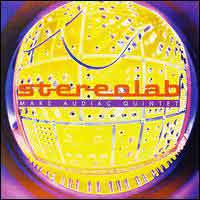 Auf mehrere Independent-Produktionen konnte die Band um die charmante
französiche Sängerin Laetitia Sadier und den englischen
Gitarristen Time Gane bereits zurückblicken, als dieses
Majordebüt erschien.
Auf mehrere Independent-Produktionen konnte die Band um die charmante
französiche Sängerin Laetitia Sadier und den englischen
Gitarristen Time Gane bereits zurückblicken, als dieses
Majordebüt erschien.

 Mehr ...
Mehr ...
By the time of 1994's Mars Audiac Quintet, Stereolab had already highlighted the rock and experimental sides of its music; now the band concentrated on perfecting its space-age pop. Sweetly bouncy songs like "Ping Pong" and "L' Enfer des Formes" streamline the band's sound without sacrificing its essence; track for track, this may be the group's most accessible, tightly written album. The groove-driven "Outer Accelerator," "Wow and Flutter," and "Transona Five" (which sounds strangely like Canned Heat's "Goin' Up the Country") reaffirm Stereolab's Krautrock roots, but the band's sweet synth melodies and vocal arrangements give it a pop patina. Even extended pieces like "Anamorphose" and "Nihilist Assault Group" -- which could have appeared on Transient Random Noise-Bursts With Announcements if they had a rawer production -- are more sensual and voluptuous than edgy and challenging. It's equally apparent on layered, complex songs such as "New Orthophony" and "The Stars Our Destination," as well as spare, minimal tracks like "Des Etoiles Electroniques," that the members of Stereolab focused their experimental energies on production tricks, vocal interplay, and increasingly electronic-based arrangements. The charming final track "Fiery Yellow" takes the band's fondness for lounge pop and experimentation to the limit; a delicate, marimba-driven piece featuring the High Llamas' Sean O'Hagan, it sounds like the kind of music Esquivel or Martin Denny would be proud to make in the '90s. While it's not as overtly innovative as some of Stereolab's earlier albums, Mars Audiac Quintet is an enjoyable, accessible forerunner to the intricate, cerebral direction the group's music would take in the mid- and late '90s.
(by Heather Phares, All Music Guide)
|
| Neil Young & Crazy Horse: "Sleeps With Angels" (Reprise, Aug. 1994) |
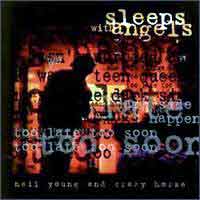 Mit
seinen alten Kollegen von Crazy Horse eingespielt, aber nicht gewohnt
krachig: auch diese Jungs beherrschen die Zwischentöne. Man höre
und staune. Mit
seinen alten Kollegen von Crazy Horse eingespielt, aber nicht gewohnt
krachig: auch diese Jungs beherrschen die Zwischentöne. Man höre
und staune. |
| Jeff Buckley: "Grace" (Columbia, Sept. 1994) |
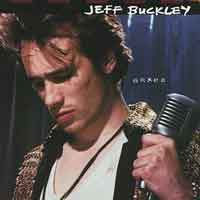 Melancholisch, sehnsüchtig, exaltiert, bombastisch, vor allem textlich reif und stilistisch vielfältig
war schon Buckleys Erstling. Ein zeitloses Stück Musik.
Melancholisch, sehnsüchtig, exaltiert, bombastisch, vor allem textlich reif und stilistisch vielfältig
war schon Buckleys Erstling. Ein zeitloses Stück Musik.
„`Grace´ sounds like a Led Zeppelin album
written by an ambitious folkie with a fondness for lounge jazz.“
(Magnet)
|
| Jackie Leven: "The Mystery Of Love Is Greater Than The Mystery Of Death" (Cooking Vinyl, Sept. 1994) |
 Das Comeback des ehemaligen Sängers von Doll By Doll:
ein wunderschönes Album eines der besten Sänger von den britischen Inseln! Zwei Lieder
ragen besonders heraus: Levens eigenes "Call Mother A Lonely Field" und der
Klassiker "I Say A Little Prayer" von Burt Bacharach.
Das Comeback des ehemaligen Sängers von Doll By Doll:
ein wunderschönes Album eines der besten Sänger von den britischen Inseln! Zwei Lieder
ragen besonders heraus: Levens eigenes "Call Mother A Lonely Field" und der
Klassiker "I Say A Little Prayer" von Burt Bacharach.
„...a stirring soul singer and poet of raw intensity...
(He) has re-emerged with new music of rare humanity and rugged emotional
grace... a man amongst men....“ (Q).
„Wisdom, bravado, thuggery... welcome back Jackie Leven...“ (Mojo)
|
| Palace Brothers: "Palace Brothers (Days In The Wake)" (Domino, Sept. 1994) |
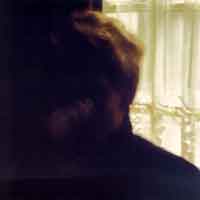 Das Album ist eigentlich eine Will Oldham Soloplatte. Aber
er wechselt nun mal gerne die Namen (u. a. "Palace Music",
einmal sogar unter dem richtigen Namen, in letzter Zeit als "Bonnie
Prince Billy"). Ich nehme mal an, dass hier nicht die Absicht
dahinter steckt, künstlich die Mysterium noch zu vergrößern:
Herr Oldham ist auch so schon verschroben genug. Hier entstand im
Geiste alter Fieldrecordings von Alan Lomax, mit sparsamer Gitarre
und brüchiger Stimme, zwischen Blues-Feeling und Country-Einfachheit,
aber immer direkt ins Herz und voller Verzweiflung und Gefühl,
ein wunderbares Album.
Das Album ist eigentlich eine Will Oldham Soloplatte. Aber
er wechselt nun mal gerne die Namen (u. a. "Palace Music",
einmal sogar unter dem richtigen Namen, in letzter Zeit als "Bonnie
Prince Billy"). Ich nehme mal an, dass hier nicht die Absicht
dahinter steckt, künstlich die Mysterium noch zu vergrößern:
Herr Oldham ist auch so schon verschroben genug. Hier entstand im
Geiste alter Fieldrecordings von Alan Lomax, mit sparsamer Gitarre
und brüchiger Stimme, zwischen Blues-Feeling und Country-Einfachheit,
aber immer direkt ins Herz und voller Verzweiflung und Gefühl,
ein wunderbares Album.

 Mehr ...
Mehr ...
|
„There's just one solitary, lonesome Palace Brother
left, wandering down twisted and tortured roads with six steel strings
and a creaky voice. Even with the very noticeable abscence of the other
siblings, it's hard to avoid making comparisons with the remarkable Palace
debut. There Is No One What What Will Take Care Of You picked at sensitive
parts of the psyche with aching laments of sin, suffering, sorrow, religious
faith and helplessness. The vague metaphors of Palace songs invite the
listener to personalize the message, and it's easy to find yourself singing
along; the melodies are simple and pure and Oldham sings as badly as you
do. The solo setting of this second album was a wise choice for the material,
which particularly dwells on loneliness. This forlorn feeling is supported
by a very casual home recording undeterred by background rain and thunder.
An adapted Kerouac axiom applies: "first take, best take"; the
imperfections are worth it to capture the passion of the moment. Oldham's
woeful ballads recall simple folk songs, country music and blues, albeit
with references to offbeat topics like 19th century Russian novelists
("Pushkin"). Like the modern poets Dylan and Jandek, Oldham
has borrowed dusty traditions to communicate original ideas and intense
emotions.“ (CMJ)
|
|
| „The third album from Kentucky's Palace Brothers sees
mainman Will Oldham as the last remaining strum and crooner on a set of
completely downbeat tunes. Billed as gothic folk and other such unhelpful
phrases, Palace Brothers' sound is akin to early Loudon Wainwright, III,
with the humour and dry wit replaced by moody, brooding melancholy. Lo-fi
in production, the intimate atmosphere and simple guitar make Will Oldham's
melodies and his off-beat lyrics even more effective as he paints incisive
pictures of God-fearing America going about its everyday life. Moving, emotional
and with a fractured vocal style reminiscent of a campfire country twang
of old, the 10 tracks are destitute and supremely depressing.” (Q.
****) |
|
| Greg Brown: "Poet Game" (Sky Ranch/Red House, Okt. 1994) |
 Stellt Euch vor, ihr packt das Beste der Sänger & Songschreiber
Van Morrison und Tom Waits zusammen, kombiniert das mit dem Gitarrenspiel
von Bruce Cockburn oder Ry Cooder. So KöNNTE man sich Greg Brown
nähern, würde ihm aber nicht gerecht werden. Immerhin hat
der Mann aus Indiana (?) hiermit bereits seine 10. Platte veröffentlicht
- beim Schreiben dieses Textes muss es bereits ca. 20 Alben geben!
Stellt Euch vor, ihr packt das Beste der Sänger & Songschreiber
Van Morrison und Tom Waits zusammen, kombiniert das mit dem Gitarrenspiel
von Bruce Cockburn oder Ry Cooder. So KöNNTE man sich Greg Brown
nähern, würde ihm aber nicht gerecht werden. Immerhin hat
der Mann aus Indiana (?) hiermit bereits seine 10. Platte veröffentlicht
- beim Schreiben dieses Textes muss es bereits ca. 20 Alben geben!
übrigens war der Mann für mich mal wieder eine Zufallsentdeckung,
diesmal für 5 Mark vom Wühltisch bei Hertie in Dinslaken.
Gedankt sei dafür an dieser Stelle Mutter EMI/Virgin und ihrem
Sublabel "Sky Ranch", wo wohl versucht wurde, Greg Brown
auf dem deutschen Musikmarkt zu etablieren. Ging natürlich schief
und alle CDs flogen dann wohl beim nächsten Aufräumen raus.
Inzwischen musste ich mir aber andere Alben von ihm für viel
Geld als Export CDs besorgen.
|
| Johnny Cash: "American Recordings" (American, Okt. 1994) |
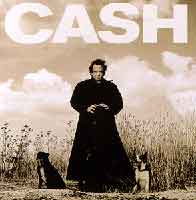 Das Comeback auf Rick Rubin's American-Label, welches bis dahin eher
durch Krach-Platten von Slayer und Danzig aufgefallen war. Rubin verpasste
Cash hier eine Produktion wie ein Stück wettergegerbtes Leder:
nur wenige Akkorde auf der akustischen Gitarre und Cashs weiser Bariton.
Weniger geht nicht. Neben einigen exzellenten eigenen Songs interpretiert
er Material von so unterschiedlichen Songwritern wie Leonard Cohen,
Loudon Wainwright III, Glenn Danzig, Nick Lowe,
Kris Kristofferson und Tom Waits. „American Recordings“
erwies sich als phänomenale Auferstehung des Man In Black.
Das Comeback auf Rick Rubin's American-Label, welches bis dahin eher
durch Krach-Platten von Slayer und Danzig aufgefallen war. Rubin verpasste
Cash hier eine Produktion wie ein Stück wettergegerbtes Leder:
nur wenige Akkorde auf der akustischen Gitarre und Cashs weiser Bariton.
Weniger geht nicht. Neben einigen exzellenten eigenen Songs interpretiert
er Material von so unterschiedlichen Songwritern wie Leonard Cohen,
Loudon Wainwright III, Glenn Danzig, Nick Lowe,
Kris Kristofferson und Tom Waits. „American Recordings“
erwies sich als phänomenale Auferstehung des Man In Black.
|
| Victoria Williams: "Loose" (Atlantic/Mammoth, Okt. 1994) |
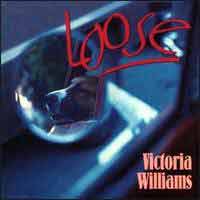 Sie
hat eine der merkwürdigsten Stimmen in der US-Singer/Songwriterszene
und schreibt wunderbare Lieder, irgendwo zwischen Country, Folk, Jazz,
Rock und Vaudeville. Was mich wundert ist, dass sie nach dieser Premiere
bei Atlantic dort inzwischen schon drei weitere wenig erfolgreiche Alben
veröffentlichen durfte und nicht, wie viele andere Kollegen, schnell
wieder rausgeflogen ist. Sie
hat eine der merkwürdigsten Stimmen in der US-Singer/Songwriterszene
und schreibt wunderbare Lieder, irgendwo zwischen Country, Folk, Jazz,
Rock und Vaudeville. Was mich wundert ist, dass sie nach dieser Premiere
bei Atlantic dort inzwischen schon drei weitere wenig erfolgreiche Alben
veröffentlichen durfte und nicht, wie viele andere Kollegen, schnell
wieder rausgeflogen ist. |
| Lambchop: "I Hope You're Sitting Down" (Merge/City Slang, Okt. 1994) |
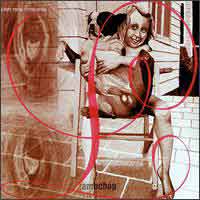 Mit
ca. 15 Bandmitgliedern inszeniert der Sänger, Gitarrist, Songschreiber
und Fußbodenverleger Kurt Wagner aus Nashville seine Version
von Country. Hörenswert und einzigartig. Mit
ca. 15 Bandmitgliedern inszeniert der Sänger, Gitarrist, Songschreiber
und Fußbodenverleger Kurt Wagner aus Nashville seine Version
von Country. Hörenswert und einzigartig. |
| Richard Buckner: "Bloomed" (Glitterhouse, Nov. 1994) |
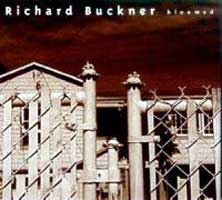 Debüt eines sehr interessanten Singer/Songwriters unter den Fittichen
von der texanischen Pedalsteel-Legende Lloyd Maines bei Deutschlands
erster Adresse für Americana. Dann gab es das noch verschrobene
Album "Since" beim Major (!) MCA, das aber wahrscheinlich
trotzdem außer mir kaum jemand gekauft hat. Anschließend habe ich den
Mann aus den Augen und den Ohren verloren. Letztes Jahr gab es dann
beim Konzert von Lucinda Williams in Amsterdam als Support einen
jungen (?) Mann zu hören, der mit verzerrter E-Gitarre und scheinbar
schlechter Laune nervte - und sich im Nachhinein (natürlich!) als
jener Richard Buckner herausstellte (sonst würde ich diese Anekdote
ja auch nicht erzählen!). Ich habe dann meine beiden CDs mal wiederrausgeholt
und dem Burschen seinen blöden Auftritt verziehen. Allerdings krieg
ich das immer noch nicht so ganz zusammen. Vielleicht hatte Herr Buckner
im Paradiso auch nur Bauchschmerzen. Bei 1000 Leuten vor der Bühne
und Lucinda im Nacken sicherlich eher als ungünstiger Zeitpunkt
einzuschätzen!
Debüt eines sehr interessanten Singer/Songwriters unter den Fittichen
von der texanischen Pedalsteel-Legende Lloyd Maines bei Deutschlands
erster Adresse für Americana. Dann gab es das noch verschrobene
Album "Since" beim Major (!) MCA, das aber wahrscheinlich
trotzdem außer mir kaum jemand gekauft hat. Anschließend habe ich den
Mann aus den Augen und den Ohren verloren. Letztes Jahr gab es dann
beim Konzert von Lucinda Williams in Amsterdam als Support einen
jungen (?) Mann zu hören, der mit verzerrter E-Gitarre und scheinbar
schlechter Laune nervte - und sich im Nachhinein (natürlich!) als
jener Richard Buckner herausstellte (sonst würde ich diese Anekdote
ja auch nicht erzählen!). Ich habe dann meine beiden CDs mal wiederrausgeholt
und dem Burschen seinen blöden Auftritt verziehen. Allerdings krieg
ich das immer noch nicht so ganz zusammen. Vielleicht hatte Herr Buckner
im Paradiso auch nur Bauchschmerzen. Bei 1000 Leuten vor der Bühne
und Lucinda im Nacken sicherlich eher als ungünstiger Zeitpunkt
einzuschätzen!
(13.11.2004)

 Mehr ...
Mehr ...
|
Produziert von Lloyd Maines (Joe Ely, Uncle Tupelo etc.), der hier auch
instrumental brilliert. Das Debüt besticht durch Richard´s
ausdrucksstarke Stimme, die düstere, melancholische Grundstimmung
und die einfühlsame, zurückgenommene Produktion.
Stimmiges Artwork. Digipak mit 6 Seiten Booklet und Texten. (Glitterhouse)
|
|
| "Die alte Ely-Truppe um Steel Spezi Lloyd Maines und
Akkordeon Mann Ponty Bone stand Richard Buckner zur Seite, um dessen Debut
`Bloomed´ äußerst inspiriert mit authentischem Texas-Flavor
zu veredeln. Dem steht in reizvollem Kontrast ein exzellenter Singer/Songwriter
gegenüber, der sich mit düsteren Ahnungen und nostalgiefreier
Rückbesinnung auf Anhieb eigenes Terrain erobert." (Rolling Stone.
4 ½ Sterne) |
|
| "Einer der größten Songwriter dieser Tage."
(Cut 12/94) |
|
| "Naturtalent mit viel Zukunftspotential." (Fachblatt
1/95) |
|
| "Er brilliert mit akustischen traurig-schönen
Countrysongs von erlesener Qualität." (Musikwoche) |
|
| "Buckner comes from the Planet of the Sexy Sad Guys,
the same planet Nick Drake, Leonard Cohen, and Kurt Cobain hail from. His
voice is sad, yet urgent. `This guy's hurting,´ you say to yourself,
even when the words don't add up to much. Buckner seems to take the pain
and heartache of country music, filter it through the Dylan philosophy of
solipsistic songwriting, and put the whole thing together with a healthy
dose of punk-rock inspired do-it-yourself-ism. Accordion, mandolin, and
dobro are used on top of Buckner's primal guitar playing to add real life
grit to the waves of emotion. I like this record, but it seems that the
emotions are more powerful than the musicianship." (Dirty Linen) |
|
| Continental Drifters (Blue Rose, Nov. 1994) |
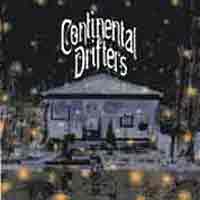 Ein
ähnlicher Fall wie die Walkabouts: zu hause in den USA völlig
unbekannt gibt es ihre Platten nur bei uns. Dabei haben (fast) alle
Mitglieder der Band eine hochkarätige Vorgeschichte: Peter Holsapple
gründete in den 80ern die kultigen, aber kommerziell erfolglosen
"dB's" und war mal kurzzeitig der 5. R.E.M. (z.B. bei "MTV
Unplugged"), Susan Cowsill war in den 60ern mit ihren Geschwistern
bei den Cowsills aktiv (wohl so was ähnliches wie die "Partridge-Family"?),
Vicki Peterson war bei den Bangles,
Mark Walton zupfte den Bass beim Dream Syndicate. Im Gegensatz
zu den beiden nachfolgenden Alben gibt es hier auch mehrere gute Coverversionen:
"Highway To The Saints" (Pat McLaughlin), "A
Song For You" (Gram Parsons), "I Can't Make It Alone"
(Carole King) und "Some Of Shelley's Blues" (Michael Nesmith). Ein
ähnlicher Fall wie die Walkabouts: zu hause in den USA völlig
unbekannt gibt es ihre Platten nur bei uns. Dabei haben (fast) alle
Mitglieder der Band eine hochkarätige Vorgeschichte: Peter Holsapple
gründete in den 80ern die kultigen, aber kommerziell erfolglosen
"dB's" und war mal kurzzeitig der 5. R.E.M. (z.B. bei "MTV
Unplugged"), Susan Cowsill war in den 60ern mit ihren Geschwistern
bei den Cowsills aktiv (wohl so was ähnliches wie die "Partridge-Family"?),
Vicki Peterson war bei den Bangles,
Mark Walton zupfte den Bass beim Dream Syndicate. Im Gegensatz
zu den beiden nachfolgenden Alben gibt es hier auch mehrere gute Coverversionen:
"Highway To The Saints" (Pat McLaughlin), "A
Song For You" (Gram Parsons), "I Can't Make It Alone"
(Carole King) und "Some Of Shelley's Blues" (Michael Nesmith). |
| Jever Mountain Boys: "Bury The Bottle With Me" (Blue Million Miles, Nov. 1993) |
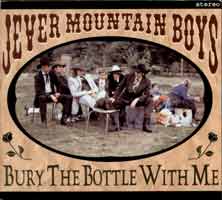 Natürlich gibt es in Ostfriesland keine Berge - und die "Mountain Boys"
sind alles Berliner Junx aus angesehenen Kapellen, die in einer Mischung
aus Witz und Heldenverehrung alte Country-Klassiker, aber auch bekannte
Rocksongs in ein Countrykorsett packen, das den Liedern ausgezeichnet
steht. Wir hören u. a. Lemmys "Ace Of Spades"
oder "Freebird" von Lynyrd Skynyrd, sowie eher unbekanntes
Material von den Beatles, den Saints und Tom Waits.
Natürlich gibt es in Ostfriesland keine Berge - und die "Mountain Boys"
sind alles Berliner Junx aus angesehenen Kapellen, die in einer Mischung
aus Witz und Heldenverehrung alte Country-Klassiker, aber auch bekannte
Rocksongs in ein Countrykorsett packen, das den Liedern ausgezeichnet
steht. Wir hören u. a. Lemmys "Ace Of Spades"
oder "Freebird" von Lynyrd Skynyrd, sowie eher unbekanntes
Material von den Beatles, den Saints und Tom Waits.
Als Sänger ist Alex Hacke von den Einstürzenden
Neubauten eine der Hauptprotagonisten, als Solist an der Lapsteel
überzeugt vor allem der ansonsten bei Nick Cave als Pianist angestellte
Roland Wolf. Dessen Tod (wann genau?) hat so weit ich es weiß
auch verhindert, dass es bei diesem Spaßprojekt zu einer Neuauflage
gekommen ist.
|
| Grant McLennan: "Horsebreaker Star" (Beggars Banquet, Nov. 1994) |
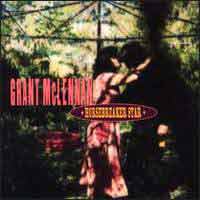 Unbestritten
sein Meisterwerk außerhalb der Go-Betweens,
eine Doppel-CD mit 2x12 Songs, eingespielt bei John Keane in
Athens/Georgia und dementsprechend relaxt amerikanisch klingend. Unbestritten
sein Meisterwerk außerhalb der Go-Betweens,
eine Doppel-CD mit 2x12 Songs, eingespielt bei John Keane in
Athens/Georgia und dementsprechend relaxt amerikanisch klingend.
„Eigentlich hatte sich dieser Grant McLennan die
Erfüllung eines alten Traums anders vorgestellt: In Nashville
hätten 24 Songs des einstigen Go-Betweens-Sängers und -Gitarristen
ihren australischen Akzent verlieren sollen. Statt dessen landete
McLennan in Athens/Georgia, und der R.E.M.-erprobte John Keane führte
Regie, als der Mann von "down under" seine Country- und
Folk-Gelüste befriedigte. Vor den Folrock-Vätern The Byrd
zieht McLennan mit der "Ballad Of Easy Rider" respektvoll
den Hut, aber seine eigenen Songs, die bisweilen an Tom Petty erinnern,
sind nicht minder gut.“ (Stereoplay)
Hier der Link zu Robert Christgau's Artikel
im Vage Voice vom 25.07.1995 über die Platte, den Künstler,
aber natürlich auch über die beste Band der Welt. (wer lacht
da? Ich meine natürlich nicht die ärzte!)
|
| The Bathers: "Lagoon Blues" (Marina, 1994) |


 Mehr ...
Mehr ...
Bounded by an elegantly moulded song construction and perfectly realised arrangements, The Bathers' majestic album is almost scuppered by its own penchant for poncification and pretension. The song titles alone (Venice Shoes, Pissoir, Via D'Oro, Ave The Leopards) are worthy nominees for Pseuds Corner. Chief Bather, singer and songwriter Chris Thompson somehow manages to brazen it out, and with the gentlest of nods to Van Morrison, Tom Waits and The Blue Nile delivers these sumptuous tunes with the born again soul intensity of a genuine Celtic troubadour, his octave-defying, swoony vocals cruise across a smoothly textured undertow of warmly caressed strings and mesmerising piano melodies on an LP which is quietly awesome.
Paul Davies Q Magazine (4 Stars)
|
| Codeine: "The White Birch" (Sub Pop, 1994) |
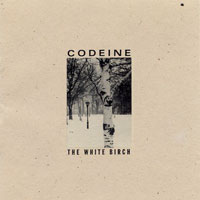 Codeine
wurden wie Galaxy 500 und Low
gerne in die "Slow-Core"-Schublade gesteckt. Ist vielleicht
gar nicht mal so falsch, klingt aber trotzdem blöd, denn es wird dieser
schönen und gleichzeitig spröden Musik wenig gerecht. Im Übrigen ist
dies das dritte und leider auch letzte Album der Band und das erste
ohne den alten Trommler Chris Brokaw, der die Band bereits 1992
verlassen hatte, um bei Come endlich
die Gitarre zu seinem Hauptinstrument machen zu können. Codeine
wurden wie Galaxy 500 und Low
gerne in die "Slow-Core"-Schublade gesteckt. Ist vielleicht
gar nicht mal so falsch, klingt aber trotzdem blöd, denn es wird dieser
schönen und gleichzeitig spröden Musik wenig gerecht. Im Übrigen ist
dies das dritte und leider auch letzte Album der Band und das erste
ohne den alten Trommler Chris Brokaw, der die Band bereits 1992
verlassen hatte, um bei Come endlich
die Gitarre zu seinem Hauptinstrument machen zu können.
(09.04.2009) |
| Iris Dement: "My Life" (Warner, 1994) |
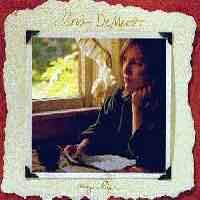 Wunderschönes
Singer/Songwriter/Country/Folk-Album. Was für 's Herz. Diese Stimme
geht einem zu Herzen. Wer da nichts spürt, der hat wohl keins. Wunderschönes
Singer/Songwriter/Country/Folk-Album. Was für 's Herz. Diese Stimme
geht einem zu Herzen. Wer da nichts spürt, der hat wohl keins. |
| Butch Hancock: "Eats Away The Night" (Glitterhouse, 1994) |
 Der Texaner Butch Hancock ist neben
Joe Ely und Jimmy Dale Gilmore eine der drei legendären Flatlanders.
Von den dreien ist er auf jeden Fall der beste Songschreiber, wenn auch
nicht unbedingt der beste Sänger. Manchmal klingt er mit seiner Stimme
und Artikulation für meinen Geschmack einfach zu sehr nach Dylan.
Allerdings ist das weniger stark ausgeprägt hier auf "Eats
Away The Night" zu hören. Unter seinen zahlreichen (und weitestgehend
unbekannten) Alben ist dies immer noch mein liebstes. Auf jeden Fall,
das erste, was ich mir damals angeschafft habe, als Hancock und die
Glitterhäusler für eine kurze Zeit mal eine Geschäftsbeziehung hatten
und ich noch nichts über die Flatlanders
wusste. Produziert vom damaligen Lucinda Williams-Sidekick Gurf
Morlix.
Der Texaner Butch Hancock ist neben
Joe Ely und Jimmy Dale Gilmore eine der drei legendären Flatlanders.
Von den dreien ist er auf jeden Fall der beste Songschreiber, wenn auch
nicht unbedingt der beste Sänger. Manchmal klingt er mit seiner Stimme
und Artikulation für meinen Geschmack einfach zu sehr nach Dylan.
Allerdings ist das weniger stark ausgeprägt hier auf "Eats
Away The Night" zu hören. Unter seinen zahlreichen (und weitestgehend
unbekannten) Alben ist dies immer noch mein liebstes. Auf jeden Fall,
das erste, was ich mir damals angeschafft habe, als Hancock und die
Glitterhäusler für eine kurze Zeit mal eine Geschäftsbeziehung hatten
und ich noch nichts über die Flatlanders
wusste. Produziert vom damaligen Lucinda Williams-Sidekick Gurf
Morlix.

 Mehr ...
Mehr ...
Butch Hancock ist einer der legend�ren Texas-Folkies. Ehedem mit den Flatlanders aktiv (Joe Ely, Jimmie Dale Gilmore) ver�ffentlichte er sieben Solo-LP�s auf seinem eigenen Label, bevor er nach 8 Jahren Pause mit "Eats Away The Night" im Herbst `94 sein Meisterwerk vorlegt.
Produziert von Gurf Morlix und mit Charlie Sexton, Jesse Taylor und Lucinda Williams� Backingband eingespielt. Die Recordings haben ein Flair, wie sie nur eine Texas-Platte haben kann. Mit einer unbezwingbar guten Version von "Boxcars" und nat�rlich seinem �bersong "(If You Were) A Bluebird". Einer der besten lebenden Songwriter und ein Sympath dazu. Die CD kommt im Digipak.
(Glitterhouse)
After about 20 years, Butch Hancock has released his first produced studio album for a national label not compiled from his previously released Rainlight Records LPs. In many ways, Hancock set his style down with his very first self-produced album, West Texas Waltz. All the elements from that period remain � the Dylanesque vocal sound, his love of wordplay, and a deep feeling for the stories that make up an individual's life. The warm sound of this album makes it easier for newcomers to get past his dry voice, and the inclusion of his hit "If You Were a Bluebird" will help a new audience locate him properly in the contemporary Texas songwriting scene. The band is tight and steps back enough to let Hancock's stories and personality shine through.
(by Richard Meyer, All Music Guide)
"Prallvoll mit erstklassigen Folksong-Perlen." (City Journal)
"Nicht nur deswegen, weil sein Sound �hnlich folkrockig ist wie der damals von Dylan, sondern weil die Qualit�t der Songs nicht viel geringer ist als das, was der Meister schrieb. Mit anderen Worten: Ein veritabler Klassiker der Legende aus Austin." (Oldiemarkt)
"Ein Mu� f�r alle Freunde des texanischen Outlaw-Countrys." (Rec Rec-Newslist)
�Die Wiederentdeckung eines gro�en Einzelk�mpfers.� (Spex)
If he's among the most underappreciated singer/songwriter in America, it's Butch Hancock's own fault. Never taking his own recordings very seriously; for years he's simply taped live performances or similarly lo-fi, impromptu events in a studio and then released them on his own poorly distributed label. This is the first Hancock album to be thoughtfully conceived, carefully recorded with a rehearsed band and efficiently distributed, and the results throw the best possible light on Hancock's raucous sense of humor and his passionate embrace of the world's most far-fetched possibilities.
"Eats Away the Night" was produced by Gurf Morlix, who brought a similarly understated folk-rock to Lucinda Williams' albums, with musicians drawn from Williams' current band and Joe Ely's old group. The producer and players add rhythmic muscle and harmonic flesh to Hancock's songs without ever getting in the way of the words, which are the main attraction. Sometimes Hancock is slyly witty, as when he complains of a woman whose "paid vacations always fell on April Fools"; at other times, he finds the words for shapeless fears, as when he warns that "time never does make things right or wrong; it just eats away the night". Four of his older songs ("If You Were a Bluebird", "Boxcars", "One Kiss" and "Baby Be Mine") finally receive worthy arrangements, and the seven new songs include such winners as the title tune, the Dylanesque blues "Junkyard in the Sun" and the live-and-let-live anthem, "To Each His Own".
|
| "Noa" (Geffen, 1994) |
|
 Vielleicht
ist die Platte in manchen Momenten etwas zu kitschig geraten (das
"Ave Maria" ist nun wirklich Geschmackssache!), aber insgesamt ist
das schöne Popmusik, irgendwo zwischen Weltmusik und Pop und
Jazz. Die Musiker (im wesentlichen ist das die Pat
Metheny Group) spielen ganz ausgezeichnet, der Gesang ist gelungen.
Vielleicht würde ich die Platte weniger mögen, wenn ich
nicht mal vor Jahren einen Film über Noa gesehen hätte?
Auf jeden Fall eine wirklich starke Frau, die sich geographisch, kulturell
und musikalisch zwischen New York und Israel bewegt. Vielleicht
ist die Platte in manchen Momenten etwas zu kitschig geraten (das
"Ave Maria" ist nun wirklich Geschmackssache!), aber insgesamt ist
das schöne Popmusik, irgendwo zwischen Weltmusik und Pop und
Jazz. Die Musiker (im wesentlichen ist das die Pat
Metheny Group) spielen ganz ausgezeichnet, der Gesang ist gelungen.
Vielleicht würde ich die Platte weniger mögen, wenn ich
nicht mal vor Jahren einen Film über Noa gesehen hätte?
Auf jeden Fall eine wirklich starke Frau, die sich geographisch, kulturell
und musikalisch zwischen New York und Israel bewegt.
"Die Lady hat Chancen, es Ofra Haza gleichzutun:
Nur visiert Achinoam Nini alias Noa, ebenfalls Israelitin jemenitischer
Abstammung, das internationale Publikum gleich zielgenauer an. Barbra
Streisand und Joni Mitchell sind ihre Vorbilder, gehobene Mainstream-Muse
zwischen Folk- und Brasil-Pop scheint ihr Ziel. Auf das steuert Produzent
Pat Metheny mit luftigen, akustikbetonten Arrangements (Eye Opener)
und Helfern wie Drummer Steve Ferrone und Noas Mentor, Gitarrist Gil
Dor, zu. Nur wirkt ihr gefühlvoller, voluminöser Gesang
zuweilen eine Spur zu gekünstelt." (Audio)
|
| The Rowan Brothers: "Tree On A Hill" (Sugar Hill, 1994) |
|
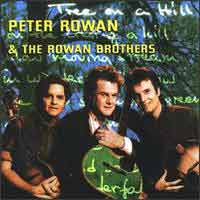 Die
Reunion der drei Brüder Chris, Lorin und Peter.
In den 70ern gab´s schon ein paar Alben mit sonnigem California
Countryrock im Fahrwasser der Eagles. Peter , der älteste und
bekannteste der drei, wird namentlich etwas hervorgehoben - es tut
aber der brüderlichen Sache keinen Abbruch. Nach wie vor singen
die drei wunderschön zusammen, die Musik ist aber stärker
bluegrassorientiert als damals. Die Begleitband ist vorzüglich
besetzt: Victor Krauss (Bruder von Alison Krauss) am Kontrabass,
Kester Smith von Taj Mahal am Schlagzeug und Geigenlegende
Richard Greene, mit dem Peter schon in den frühen 70ern
bei Seatrain spielte. Die
Reunion der drei Brüder Chris, Lorin und Peter.
In den 70ern gab´s schon ein paar Alben mit sonnigem California
Countryrock im Fahrwasser der Eagles. Peter , der älteste und
bekannteste der drei, wird namentlich etwas hervorgehoben - es tut
aber der brüderlichen Sache keinen Abbruch. Nach wie vor singen
die drei wunderschön zusammen, die Musik ist aber stärker
bluegrassorientiert als damals. Die Begleitband ist vorzüglich
besetzt: Victor Krauss (Bruder von Alison Krauss) am Kontrabass,
Kester Smith von Taj Mahal am Schlagzeug und Geigenlegende
Richard Greene, mit dem Peter schon in den frühen 70ern
bei Seatrain spielte.
Von den Songs möchte ich euch zwei von Townes Van Zandt
ans Herz legen: den Klassiker "No Lonesome Tune" und das
wunderbare "I´ll Be There", das Townes zusammen mit
Peter und Chris Rowan verfasste.
|
| The Sea And Cake (Rough Trade, 1994) |
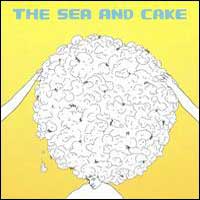 The Sea and Cake ist eine Post-Rock-Supergruppe insofern, dass alle
Beteiligten aus Chicagos Independent-Szene stammen und schon einen gewissen
Ruf haben: Sänger/Gitarrist Sam Prekop war zusammen mit
Bassist Eric Claridge auf dem Shrimp Boat. Nach dessen
Ausserdienststellung bekamen beide die Möglichkeit, ein neues Studioprojekt
zu starten und engagierten den Coctails-Gitarristen
Archer Prewitt und den Tortoise
Trommler John McEntire. Eigentlich nur als "one-off project"
geplant wurde daraus dann aber eine richtige Band, da sich die Musiker
entschließen konnten, ihre Zusammenarbeit fortzusetzen und auch live
aufzutreten. Der Bandname ergab sich daraus, dass McEntire "The
C in Cake" den Titel eines Songs von Gastr del Sol (eine
weitere Indie-Kultband bzw. ein Projekt von Jim O'Rourke) falsch
verstanden hatte. Es entstand in Zusammenarbeit mit Toningenieur, Trommler
und Saxophonist Brad Wood dieses großartige Debütalbum mit
seiner einzigartigen Mischung aus Leicht- und Schwerverdaulichem, aus
Indierock, Jazz, Latin, ja sogar Krautrock, manchmal instrumental, zumeist
aber als Grundlage für die Texte und den Gesang von Prekop.
The Sea and Cake ist eine Post-Rock-Supergruppe insofern, dass alle
Beteiligten aus Chicagos Independent-Szene stammen und schon einen gewissen
Ruf haben: Sänger/Gitarrist Sam Prekop war zusammen mit
Bassist Eric Claridge auf dem Shrimp Boat. Nach dessen
Ausserdienststellung bekamen beide die Möglichkeit, ein neues Studioprojekt
zu starten und engagierten den Coctails-Gitarristen
Archer Prewitt und den Tortoise
Trommler John McEntire. Eigentlich nur als "one-off project"
geplant wurde daraus dann aber eine richtige Band, da sich die Musiker
entschließen konnten, ihre Zusammenarbeit fortzusetzen und auch live
aufzutreten. Der Bandname ergab sich daraus, dass McEntire "The
C in Cake" den Titel eines Songs von Gastr del Sol (eine
weitere Indie-Kultband bzw. ein Projekt von Jim O'Rourke) falsch
verstanden hatte. Es entstand in Zusammenarbeit mit Toningenieur, Trommler
und Saxophonist Brad Wood dieses großartige Debütalbum mit
seiner einzigartigen Mischung aus Leicht- und Schwerverdaulichem, aus
Indierock, Jazz, Latin, ja sogar Krautrock, manchmal instrumental, zumeist
aber als Grundlage für die Texte und den Gesang von Prekop.
(08.07.2004)

 Mehr ...
Mehr ...
| The Sea and Cake's buoyant debut is a breath of fresh air,
an utterly distinctive and innovative work which expands the scope of frontman
Sam Prekop's work in the great Shrimp Boat to incorporate a new fascination
with Afro-Caribbean rhythms and textures. Recorded by Brad Wood, the album
simply glows -- Prekop's dry vocals and free-associative lyrics skip along
a shimmering and lushly pastoral backdrop which nimbly fuses pop, soul,
jazz and even prog rock; tracks like "Jacking the Ball," "Flat
Lay the Water," and "Showboat Angel" are as seductive as
they are elusive. (Jason Ankeny, AMG) |
|
 weitere Highlights ...
weitere Highlights ... 
 Mehr ...
Mehr ...
 Für Eingeweihte der Killer im Cacavas-Programm. In definitiver Neil &
Crazy Horse Nähe ... Und ein tolles Cover! In diese blassblonde
Hölle würde sich sicherlich mancher von uns gerne begeben!
Für Eingeweihte der Killer im Cacavas-Programm. In definitiver Neil &
Crazy Horse Nähe ... Und ein tolles Cover! In diese blassblonde
Hölle würde sich sicherlich mancher von uns gerne begeben!
 Mehr ...
Mehr ...

 Mehr ...
Mehr ...
 Kicking Against The Pricks ]
Kicking Against The Pricks ]
 Mehr ...
Mehr ...
 Ich bin eigentlich kein sonderlich großer Cockburn-Fan - aber etwas
kurioserweise sind gerade seine beiden 90er-Alben beim Majorlabel
Sony/Columbia für mich deutlich seine besten. Das liegt vielleicht
an den guten Produktionsbedingungen (beide sind von T-Bone Burnett
betreut und klingen phantastisch!), den erstklassigen Musikern (u.
a. Elvis-Bassist Jerry Scheff, Drummer Mickey Curry,
Landsmann Richard Bell von The Band am Piano und den Slidegitarrenmeistern
Greg Leisz und Colin Linden) und natürlich den
guten Songs des Kanadiers Cockburn.
Ich bin eigentlich kein sonderlich großer Cockburn-Fan - aber etwas
kurioserweise sind gerade seine beiden 90er-Alben beim Majorlabel
Sony/Columbia für mich deutlich seine besten. Das liegt vielleicht
an den guten Produktionsbedingungen (beide sind von T-Bone Burnett
betreut und klingen phantastisch!), den erstklassigen Musikern (u.
a. Elvis-Bassist Jerry Scheff, Drummer Mickey Curry,
Landsmann Richard Bell von The Band am Piano und den Slidegitarrenmeistern
Greg Leisz und Colin Linden) und natürlich den
guten Songs des Kanadiers Cockburn.
 Mehr ...
Mehr ...
 Mal wieder ein schönes Studioalbum von Frau Harris, eingespielt z.T. mit den Nash Ramblers (Sam Bush,
Jon Randall, Al Perkins, Roy Huskey, Larry Atamanuik), aber nicht mehr so
bluegrassmäßig wie der Vorgänger Live At The Ryman.
Mal wieder ein schönes Studioalbum von Frau Harris, eingespielt z.T. mit den Nash Ramblers (Sam Bush,
Jon Randall, Al Perkins, Roy Huskey, Larry Atamanuik), aber nicht mehr so
bluegrassmäßig wie der Vorgänger Live At The Ryman.
 Mehr ...
Mehr ...
 Zweites Album der Band um den ehemaligen Yo La Tengo-Gitarristen David Schramm.
Der einzigen Coverversion auf der Platte gebührt die Ehre, auch für Waiting For Louise einen Konzertklassiker gefunden zu haben:
"Side Of The Road" von Lucinda Williams!
Zweites Album der Band um den ehemaligen Yo La Tengo-Gitarristen David Schramm.
Der einzigen Coverversion auf der Platte gebührt die Ehre, auch für Waiting For Louise einen Konzertklassiker gefunden zu haben:
"Side Of The Road" von Lucinda Williams!
 Mehr ...
Mehr ...
 Das
wunderschöne und - leider - einzige Soloalbum des ehemaligen Sängers
und Songschreibers der Triffids,
nach den Go-Betweens und noch vor
The Church und Crowded
House meine liebste Band aus Australien.
Das
wunderschöne und - leider - einzige Soloalbum des ehemaligen Sängers
und Songschreibers der Triffids,
nach den Go-Betweens und noch vor
The Church und Crowded
House meine liebste Band aus Australien.
 Mehr ...
Mehr ...
 Ihr
letztes reguläres Studio-Werk auf Glitterhouse, vor dem Wechsel
zu Virgin. Vom Gefühl her liegt es mittig zwischen der rockigeren
"New West Motel" und
der folkigen "Satisfied Mind".
12 Songs, von denen vor allem "Bordertown", "Sand &
Gravel", "Graveyard" und "Promised" (welches
direkt von "Satisfied Mind" stammen könnte) auf eine
"Best Of" gehören (gäbe es eine).
Ihr
letztes reguläres Studio-Werk auf Glitterhouse, vor dem Wechsel
zu Virgin. Vom Gefühl her liegt es mittig zwischen der rockigeren
"New West Motel" und
der folkigen "Satisfied Mind".
12 Songs, von denen vor allem "Bordertown", "Sand &
Gravel", "Graveyard" und "Promised" (welches
direkt von "Satisfied Mind" stammen könnte) auf eine
"Best Of" gehören (gäbe es eine).
 10
Jahre nach dem Debüt "Eden"
mal wieder ein Album von Tracy Thorn und Ben Watt, das
mir rundherum gefällt, was vor allem an der Rückkehr zum alten
folkig-jazzigen Sound, diesmal von England Folk-Kontrabass-Legende Danny
Thompson und Ex-Fairport Convention-Trommler Dave Mattacks
mit Perkussiont Martin Ditcham (den man vor allem von Talk
Talk-Platten kennt) erzeugt. Aber natürlich sind wie immer
die Stimme von Tracy und die Songs das Wichtigste. Herausragend für
mich die Eröffnungsnummer "Rollercoaster" mit einer hübschen
Minimoog-Melodie. Im Oktober 1995 wurde kurioserweise der Titel "Missing
You" in einer Disco-Remix-version mit einem kräftigen Computerbeat
zu einem der größten Hits der Band. Ich mag natürlich
das spartanische Original viel lieber, gönne den beiden aber natürlich
den späten & unverhofften Riesenerfolg.
10
Jahre nach dem Debüt "Eden"
mal wieder ein Album von Tracy Thorn und Ben Watt, das
mir rundherum gefällt, was vor allem an der Rückkehr zum alten
folkig-jazzigen Sound, diesmal von England Folk-Kontrabass-Legende Danny
Thompson und Ex-Fairport Convention-Trommler Dave Mattacks
mit Perkussiont Martin Ditcham (den man vor allem von Talk
Talk-Platten kennt) erzeugt. Aber natürlich sind wie immer
die Stimme von Tracy und die Songs das Wichtigste. Herausragend für
mich die Eröffnungsnummer "Rollercoaster" mit einer hübschen
Minimoog-Melodie. Im Oktober 1995 wurde kurioserweise der Titel "Missing
You" in einer Disco-Remix-version mit einem kräftigen Computerbeat
zu einem der größten Hits der Band. Ich mag natürlich
das spartanische Original viel lieber, gönne den beiden aber natürlich
den späten & unverhofften Riesenerfolg. Der Ex-Go-Betweens-Sänger mit
seiner Sammlung von Lieblingsliedern anderer Autoren. Wird von vielen
Spezis nicht als seine Glanztat eingeschätzt. Ich als alter Fan
schöner Coverversionen find es aber toll!
Der Ex-Go-Betweens-Sänger mit
seiner Sammlung von Lieblingsliedern anderer Autoren. Wird von vielen
Spezis nicht als seine Glanztat eingeschätzt. Ich als alter Fan
schöner Coverversionen find es aber toll!
 Mehr ...
Mehr ...
 Auf mehrere Independent-Produktionen konnte die Band um die charmante
französiche Sängerin Laetitia Sadier und den englischen
Gitarristen Time Gane bereits zurückblicken, als dieses
Majordebüt erschien.
Auf mehrere Independent-Produktionen konnte die Band um die charmante
französiche Sängerin Laetitia Sadier und den englischen
Gitarristen Time Gane bereits zurückblicken, als dieses
Majordebüt erschien.
 Mehr ...
Mehr ...
 Mit
seinen alten Kollegen von Crazy Horse eingespielt, aber nicht gewohnt
krachig: auch diese Jungs beherrschen die Zwischentöne. Man höre
und staune.
Mit
seinen alten Kollegen von Crazy Horse eingespielt, aber nicht gewohnt
krachig: auch diese Jungs beherrschen die Zwischentöne. Man höre
und staune. Melancholisch, sehnsüchtig, exaltiert, bombastisch, vor allem textlich reif und stilistisch vielfältig
war schon Buckleys Erstling. Ein zeitloses Stück Musik.
Melancholisch, sehnsüchtig, exaltiert, bombastisch, vor allem textlich reif und stilistisch vielfältig
war schon Buckleys Erstling. Ein zeitloses Stück Musik.
 Das Comeback des ehemaligen Sängers von Doll By Doll:
ein wunderschönes Album eines der besten Sänger von den britischen Inseln! Zwei Lieder
ragen besonders heraus: Levens eigenes "Call Mother A Lonely Field" und der
Klassiker "I Say A Little Prayer" von Burt Bacharach.
Das Comeback des ehemaligen Sängers von Doll By Doll:
ein wunderschönes Album eines der besten Sänger von den britischen Inseln! Zwei Lieder
ragen besonders heraus: Levens eigenes "Call Mother A Lonely Field" und der
Klassiker "I Say A Little Prayer" von Burt Bacharach.
 Das Album ist eigentlich eine Will Oldham Soloplatte. Aber
er wechselt nun mal gerne die Namen (u. a. "Palace Music",
einmal sogar unter dem richtigen Namen, in letzter Zeit als "Bonnie
Prince Billy"). Ich nehme mal an, dass hier nicht die Absicht
dahinter steckt, künstlich die Mysterium noch zu vergrößern:
Herr Oldham ist auch so schon verschroben genug. Hier entstand im
Geiste alter Fieldrecordings von Alan Lomax, mit sparsamer Gitarre
und brüchiger Stimme, zwischen Blues-Feeling und Country-Einfachheit,
aber immer direkt ins Herz und voller Verzweiflung und Gefühl,
ein wunderbares Album.
Das Album ist eigentlich eine Will Oldham Soloplatte. Aber
er wechselt nun mal gerne die Namen (u. a. "Palace Music",
einmal sogar unter dem richtigen Namen, in letzter Zeit als "Bonnie
Prince Billy"). Ich nehme mal an, dass hier nicht die Absicht
dahinter steckt, künstlich die Mysterium noch zu vergrößern:
Herr Oldham ist auch so schon verschroben genug. Hier entstand im
Geiste alter Fieldrecordings von Alan Lomax, mit sparsamer Gitarre
und brüchiger Stimme, zwischen Blues-Feeling und Country-Einfachheit,
aber immer direkt ins Herz und voller Verzweiflung und Gefühl,
ein wunderbares Album.
 Mehr ...
Mehr ...
 Stellt Euch vor, ihr packt das Beste der Sänger & Songschreiber
Van Morrison und Tom Waits zusammen, kombiniert das mit dem Gitarrenspiel
von Bruce Cockburn oder Ry Cooder. So KöNNTE man sich Greg Brown
nähern, würde ihm aber nicht gerecht werden. Immerhin hat
der Mann aus Indiana (?) hiermit bereits seine 10. Platte veröffentlicht
- beim Schreiben dieses Textes muss es bereits ca. 20 Alben geben!
Stellt Euch vor, ihr packt das Beste der Sänger & Songschreiber
Van Morrison und Tom Waits zusammen, kombiniert das mit dem Gitarrenspiel
von Bruce Cockburn oder Ry Cooder. So KöNNTE man sich Greg Brown
nähern, würde ihm aber nicht gerecht werden. Immerhin hat
der Mann aus Indiana (?) hiermit bereits seine 10. Platte veröffentlicht
- beim Schreiben dieses Textes muss es bereits ca. 20 Alben geben!
 Das Comeback auf Rick Rubin's American-Label, welches bis dahin eher
durch Krach-Platten von Slayer und Danzig aufgefallen war. Rubin verpasste
Cash hier eine Produktion wie ein Stück wettergegerbtes Leder:
nur wenige Akkorde auf der akustischen Gitarre und Cashs weiser Bariton.
Weniger geht nicht. Neben einigen exzellenten eigenen Songs interpretiert
er Material von so unterschiedlichen Songwritern wie Leonard Cohen,
Loudon Wainwright III, Glenn Danzig, Nick Lowe,
Kris Kristofferson und Tom Waits. „American Recordings“
erwies sich als phänomenale Auferstehung des Man In Black.
Das Comeback auf Rick Rubin's American-Label, welches bis dahin eher
durch Krach-Platten von Slayer und Danzig aufgefallen war. Rubin verpasste
Cash hier eine Produktion wie ein Stück wettergegerbtes Leder:
nur wenige Akkorde auf der akustischen Gitarre und Cashs weiser Bariton.
Weniger geht nicht. Neben einigen exzellenten eigenen Songs interpretiert
er Material von so unterschiedlichen Songwritern wie Leonard Cohen,
Loudon Wainwright III, Glenn Danzig, Nick Lowe,
Kris Kristofferson und Tom Waits. „American Recordings“
erwies sich als phänomenale Auferstehung des Man In Black.
 Sie
hat eine der merkwürdigsten Stimmen in der US-Singer/Songwriterszene
und schreibt wunderbare Lieder, irgendwo zwischen Country, Folk, Jazz,
Rock und Vaudeville. Was mich wundert ist, dass sie nach dieser Premiere
bei Atlantic dort inzwischen schon drei weitere wenig erfolgreiche Alben
veröffentlichen durfte und nicht, wie viele andere Kollegen, schnell
wieder rausgeflogen ist.
Sie
hat eine der merkwürdigsten Stimmen in der US-Singer/Songwriterszene
und schreibt wunderbare Lieder, irgendwo zwischen Country, Folk, Jazz,
Rock und Vaudeville. Was mich wundert ist, dass sie nach dieser Premiere
bei Atlantic dort inzwischen schon drei weitere wenig erfolgreiche Alben
veröffentlichen durfte und nicht, wie viele andere Kollegen, schnell
wieder rausgeflogen ist.  Mit
ca. 15 Bandmitgliedern inszeniert der Sänger, Gitarrist, Songschreiber
und Fußbodenverleger Kurt Wagner aus Nashville seine Version
von Country. Hörenswert und einzigartig.
Mit
ca. 15 Bandmitgliedern inszeniert der Sänger, Gitarrist, Songschreiber
und Fußbodenverleger Kurt Wagner aus Nashville seine Version
von Country. Hörenswert und einzigartig. Debüt eines sehr interessanten Singer/Songwriters unter den Fittichen
von der texanischen Pedalsteel-Legende Lloyd Maines bei Deutschlands
erster Adresse für Americana. Dann gab es das noch verschrobene
Album "Since" beim Major (!) MCA, das aber wahrscheinlich
trotzdem außer mir kaum jemand gekauft hat. Anschließend habe ich den
Mann aus den Augen und den Ohren verloren. Letztes Jahr gab es dann
beim Konzert von Lucinda Williams in Amsterdam als Support einen
jungen (?) Mann zu hören, der mit verzerrter E-Gitarre und scheinbar
schlechter Laune nervte - und sich im Nachhinein (natürlich!) als
jener Richard Buckner herausstellte (sonst würde ich diese Anekdote
ja auch nicht erzählen!). Ich habe dann meine beiden CDs mal wiederrausgeholt
und dem Burschen seinen blöden Auftritt verziehen. Allerdings krieg
ich das immer noch nicht so ganz zusammen. Vielleicht hatte Herr Buckner
im Paradiso auch nur Bauchschmerzen. Bei 1000 Leuten vor der Bühne
und Lucinda im Nacken sicherlich eher als ungünstiger Zeitpunkt
einzuschätzen!
Debüt eines sehr interessanten Singer/Songwriters unter den Fittichen
von der texanischen Pedalsteel-Legende Lloyd Maines bei Deutschlands
erster Adresse für Americana. Dann gab es das noch verschrobene
Album "Since" beim Major (!) MCA, das aber wahrscheinlich
trotzdem außer mir kaum jemand gekauft hat. Anschließend habe ich den
Mann aus den Augen und den Ohren verloren. Letztes Jahr gab es dann
beim Konzert von Lucinda Williams in Amsterdam als Support einen
jungen (?) Mann zu hören, der mit verzerrter E-Gitarre und scheinbar
schlechter Laune nervte - und sich im Nachhinein (natürlich!) als
jener Richard Buckner herausstellte (sonst würde ich diese Anekdote
ja auch nicht erzählen!). Ich habe dann meine beiden CDs mal wiederrausgeholt
und dem Burschen seinen blöden Auftritt verziehen. Allerdings krieg
ich das immer noch nicht so ganz zusammen. Vielleicht hatte Herr Buckner
im Paradiso auch nur Bauchschmerzen. Bei 1000 Leuten vor der Bühne
und Lucinda im Nacken sicherlich eher als ungünstiger Zeitpunkt
einzuschätzen! Mehr ...
Mehr ...
 Ein
ähnlicher Fall wie die Walkabouts: zu hause in den USA völlig
unbekannt gibt es ihre Platten nur bei uns. Dabei haben (fast) alle
Mitglieder der Band eine hochkarätige Vorgeschichte: Peter Holsapple
gründete in den 80ern die kultigen, aber kommerziell erfolglosen
"dB's" und war mal kurzzeitig der 5. R.E.M. (z.B. bei "MTV
Unplugged"), Susan Cowsill war in den 60ern mit ihren Geschwistern
bei den Cowsills aktiv (wohl so was ähnliches wie die "Partridge-Family"?),
Vicki Peterson war bei den Bangles,
Mark Walton zupfte den Bass beim Dream Syndicate. Im Gegensatz
zu den beiden nachfolgenden Alben gibt es hier auch mehrere gute Coverversionen:
"Highway To The Saints" (Pat McLaughlin), "A
Song For You" (Gram Parsons), "I Can't Make It Alone"
(Carole King) und "Some Of Shelley's Blues" (Michael Nesmith).
Ein
ähnlicher Fall wie die Walkabouts: zu hause in den USA völlig
unbekannt gibt es ihre Platten nur bei uns. Dabei haben (fast) alle
Mitglieder der Band eine hochkarätige Vorgeschichte: Peter Holsapple
gründete in den 80ern die kultigen, aber kommerziell erfolglosen
"dB's" und war mal kurzzeitig der 5. R.E.M. (z.B. bei "MTV
Unplugged"), Susan Cowsill war in den 60ern mit ihren Geschwistern
bei den Cowsills aktiv (wohl so was ähnliches wie die "Partridge-Family"?),
Vicki Peterson war bei den Bangles,
Mark Walton zupfte den Bass beim Dream Syndicate. Im Gegensatz
zu den beiden nachfolgenden Alben gibt es hier auch mehrere gute Coverversionen:
"Highway To The Saints" (Pat McLaughlin), "A
Song For You" (Gram Parsons), "I Can't Make It Alone"
(Carole King) und "Some Of Shelley's Blues" (Michael Nesmith). Natürlich gibt es in Ostfriesland keine Berge - und die "Mountain Boys"
sind alles Berliner Junx aus angesehenen Kapellen, die in einer Mischung
aus Witz und Heldenverehrung alte Country-Klassiker, aber auch bekannte
Rocksongs in ein Countrykorsett packen, das den Liedern ausgezeichnet
steht. Wir hören u. a. Lemmys "Ace Of Spades"
oder "Freebird" von Lynyrd Skynyrd, sowie eher unbekanntes
Material von den Beatles, den Saints und Tom Waits.
Natürlich gibt es in Ostfriesland keine Berge - und die "Mountain Boys"
sind alles Berliner Junx aus angesehenen Kapellen, die in einer Mischung
aus Witz und Heldenverehrung alte Country-Klassiker, aber auch bekannte
Rocksongs in ein Countrykorsett packen, das den Liedern ausgezeichnet
steht. Wir hören u. a. Lemmys "Ace Of Spades"
oder "Freebird" von Lynyrd Skynyrd, sowie eher unbekanntes
Material von den Beatles, den Saints und Tom Waits. Unbestritten
sein Meisterwerk außerhalb der Go-Betweens,
eine Doppel-CD mit 2x12 Songs, eingespielt bei John Keane in
Athens/Georgia und dementsprechend relaxt amerikanisch klingend.
Unbestritten
sein Meisterwerk außerhalb der Go-Betweens,
eine Doppel-CD mit 2x12 Songs, eingespielt bei John Keane in
Athens/Georgia und dementsprechend relaxt amerikanisch klingend.

 Mehr ...
Mehr ...
 Codeine
wurden wie Galaxy 500 und Low
gerne in die "Slow-Core"-Schublade gesteckt. Ist vielleicht
gar nicht mal so falsch, klingt aber trotzdem blöd, denn es wird dieser
schönen und gleichzeitig spröden Musik wenig gerecht. Im Übrigen ist
dies das dritte und leider auch letzte Album der Band und das erste
ohne den alten Trommler Chris Brokaw, der die Band bereits 1992
verlassen hatte, um bei Come endlich
die Gitarre zu seinem Hauptinstrument machen zu können.
Codeine
wurden wie Galaxy 500 und Low
gerne in die "Slow-Core"-Schublade gesteckt. Ist vielleicht
gar nicht mal so falsch, klingt aber trotzdem blöd, denn es wird dieser
schönen und gleichzeitig spröden Musik wenig gerecht. Im Übrigen ist
dies das dritte und leider auch letzte Album der Band und das erste
ohne den alten Trommler Chris Brokaw, der die Band bereits 1992
verlassen hatte, um bei Come endlich
die Gitarre zu seinem Hauptinstrument machen zu können. Wunderschönes
Singer/Songwriter/Country/Folk-Album. Was für 's Herz. Diese Stimme
geht einem zu Herzen. Wer da nichts spürt, der hat wohl keins.
Wunderschönes
Singer/Songwriter/Country/Folk-Album. Was für 's Herz. Diese Stimme
geht einem zu Herzen. Wer da nichts spürt, der hat wohl keins. Der Texaner Butch Hancock ist neben
Joe Ely und Jimmy Dale Gilmore eine der drei legendären Flatlanders.
Von den dreien ist er auf jeden Fall der beste Songschreiber, wenn auch
nicht unbedingt der beste Sänger. Manchmal klingt er mit seiner Stimme
und Artikulation für meinen Geschmack einfach zu sehr nach Dylan.
Allerdings ist das weniger stark ausgeprägt hier auf "Eats
Away The Night" zu hören. Unter seinen zahlreichen (und weitestgehend
unbekannten) Alben ist dies immer noch mein liebstes. Auf jeden Fall,
das erste, was ich mir damals angeschafft habe, als Hancock und die
Glitterhäusler für eine kurze Zeit mal eine Geschäftsbeziehung hatten
und ich noch nichts über die Flatlanders
wusste. Produziert vom damaligen Lucinda Williams-Sidekick Gurf
Morlix.
Der Texaner Butch Hancock ist neben
Joe Ely und Jimmy Dale Gilmore eine der drei legendären Flatlanders.
Von den dreien ist er auf jeden Fall der beste Songschreiber, wenn auch
nicht unbedingt der beste Sänger. Manchmal klingt er mit seiner Stimme
und Artikulation für meinen Geschmack einfach zu sehr nach Dylan.
Allerdings ist das weniger stark ausgeprägt hier auf "Eats
Away The Night" zu hören. Unter seinen zahlreichen (und weitestgehend
unbekannten) Alben ist dies immer noch mein liebstes. Auf jeden Fall,
das erste, was ich mir damals angeschafft habe, als Hancock und die
Glitterhäusler für eine kurze Zeit mal eine Geschäftsbeziehung hatten
und ich noch nichts über die Flatlanders
wusste. Produziert vom damaligen Lucinda Williams-Sidekick Gurf
Morlix.
 Mehr ...
Mehr ...
 The Sea and Cake ist eine Post-Rock-Supergruppe insofern, dass alle
Beteiligten aus Chicagos Independent-Szene stammen und schon einen gewissen
Ruf haben: Sänger/Gitarrist Sam Prekop war zusammen mit
Bassist Eric Claridge auf dem Shrimp Boat. Nach dessen
Ausserdienststellung bekamen beide die Möglichkeit, ein neues Studioprojekt
zu starten und engagierten den Coctails-Gitarristen
Archer Prewitt und den Tortoise
Trommler John McEntire. Eigentlich nur als "one-off project"
geplant wurde daraus dann aber eine richtige Band, da sich die Musiker
entschließen konnten, ihre Zusammenarbeit fortzusetzen und auch live
aufzutreten. Der Bandname ergab sich daraus, dass McEntire "The
C in Cake" den Titel eines Songs von Gastr del Sol (eine
weitere Indie-Kultband bzw. ein Projekt von Jim O'Rourke) falsch
verstanden hatte. Es entstand in Zusammenarbeit mit Toningenieur, Trommler
und Saxophonist Brad Wood dieses großartige Debütalbum mit
seiner einzigartigen Mischung aus Leicht- und Schwerverdaulichem, aus
Indierock, Jazz, Latin, ja sogar Krautrock, manchmal instrumental, zumeist
aber als Grundlage für die Texte und den Gesang von Prekop.
The Sea and Cake ist eine Post-Rock-Supergruppe insofern, dass alle
Beteiligten aus Chicagos Independent-Szene stammen und schon einen gewissen
Ruf haben: Sänger/Gitarrist Sam Prekop war zusammen mit
Bassist Eric Claridge auf dem Shrimp Boat. Nach dessen
Ausserdienststellung bekamen beide die Möglichkeit, ein neues Studioprojekt
zu starten und engagierten den Coctails-Gitarristen
Archer Prewitt und den Tortoise
Trommler John McEntire. Eigentlich nur als "one-off project"
geplant wurde daraus dann aber eine richtige Band, da sich die Musiker
entschließen konnten, ihre Zusammenarbeit fortzusetzen und auch live
aufzutreten. Der Bandname ergab sich daraus, dass McEntire "The
C in Cake" den Titel eines Songs von Gastr del Sol (eine
weitere Indie-Kultband bzw. ein Projekt von Jim O'Rourke) falsch
verstanden hatte. Es entstand in Zusammenarbeit mit Toningenieur, Trommler
und Saxophonist Brad Wood dieses großartige Debütalbum mit
seiner einzigartigen Mischung aus Leicht- und Schwerverdaulichem, aus
Indierock, Jazz, Latin, ja sogar Krautrock, manchmal instrumental, zumeist
aber als Grundlage für die Texte und den Gesang von Prekop.  Mehr ...
Mehr ...
 Ein fantastisches Debüt der Sängerin! Allerdings kam der Riesenerfolg
dann doch etwas überraschend, denn damals lag das Album zuerst
wie Blei in den Regalen der Plattenläden. Erst die zweite Single
"All I Wanna Do" samt Video brachte dann den Durchbruch.
Ein fantastisches Debüt der Sängerin! Allerdings kam der Riesenerfolg
dann doch etwas überraschend, denn damals lag das Album zuerst
wie Blei in den Regalen der Plattenläden. Erst die zweite Single
"All I Wanna Do" samt Video brachte dann den Durchbruch.
 Vielleicht
ist die Platte in manchen Momenten etwas zu kitschig geraten (das
"Ave Maria" ist nun wirklich Geschmackssache!), aber insgesamt ist
das schöne Popmusik, irgendwo zwischen Weltmusik und Pop und
Jazz. Die Musiker (im wesentlichen ist das die
Vielleicht
ist die Platte in manchen Momenten etwas zu kitschig geraten (das
"Ave Maria" ist nun wirklich Geschmackssache!), aber insgesamt ist
das schöne Popmusik, irgendwo zwischen Weltmusik und Pop und
Jazz. Die Musiker (im wesentlichen ist das die  Die
Reunion der drei Brüder Chris, Lorin und Peter.
In den 70ern gab´s schon ein paar Alben mit sonnigem California
Countryrock im Fahrwasser der Eagles. Peter , der älteste und
bekannteste der drei, wird namentlich etwas hervorgehoben - es tut
aber der brüderlichen Sache keinen Abbruch. Nach wie vor singen
die drei wunderschön zusammen, die Musik ist aber stärker
bluegrassorientiert als damals. Die Begleitband ist vorzüglich
besetzt: Victor Krauss (Bruder von Alison Krauss) am Kontrabass,
Kester Smith von Taj Mahal am Schlagzeug und Geigenlegende
Richard Greene, mit dem Peter schon in den frühen 70ern
bei
Die
Reunion der drei Brüder Chris, Lorin und Peter.
In den 70ern gab´s schon ein paar Alben mit sonnigem California
Countryrock im Fahrwasser der Eagles. Peter , der älteste und
bekannteste der drei, wird namentlich etwas hervorgehoben - es tut
aber der brüderlichen Sache keinen Abbruch. Nach wie vor singen
die drei wunderschön zusammen, die Musik ist aber stärker
bluegrassorientiert als damals. Die Begleitband ist vorzüglich
besetzt: Victor Krauss (Bruder von Alison Krauss) am Kontrabass,
Kester Smith von Taj Mahal am Schlagzeug und Geigenlegende
Richard Greene, mit dem Peter schon in den frühen 70ern
bei
(2002-12-03)
Kürzlich habe ich mir die Vinylausgabe der Platte gegönnt, die es 1994 noch nicht gab. Das Album ist eigentlich besser, als ich das hier vor ein paar Jahren mal hier geschrieben habe. Auf jeden Fall ist es ein Cave-Klassiker und gefällt mir viel besser als das aktuelle Zeug vom Meister. Für mich gibt es dafür eine einfache Erklärung: damals haben vor allem die Gitarren von Mick Harvey und Blixa Bargeld den Sound geprägt. Deren Job hat ja inzwischen der Multi-Instrumentalist Warren Ellis übernommen, der hier schon einen (ersten?) Gastauftritt als Geiger hat.
(2024-12-15)